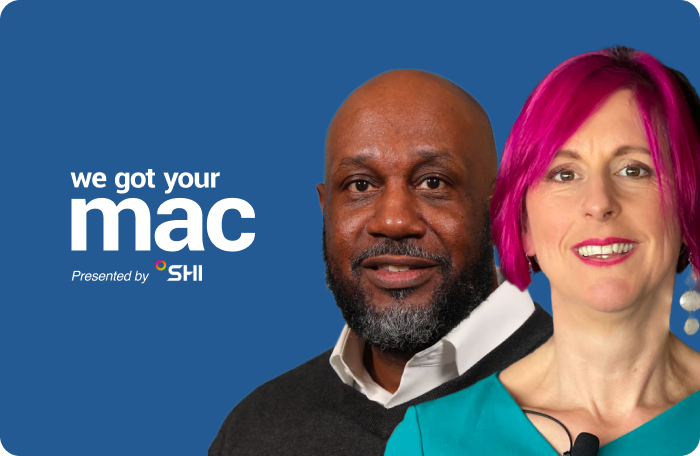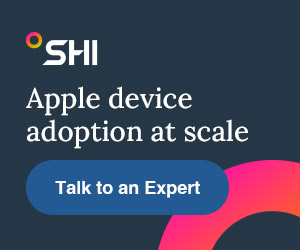As with any business change, it is essential to build a business use case for deploying Mac at scale – and it’s particularly important when you’re switching to devices perceived as having a high price point. Several (if not all) departments will be impacted in some way by the shift, meaning each department should be involved in the research for this change.
Finance, asset management, business units, and IT should all be involved from the beginning of the process. Building a strong, successful business case will require addressing their concerns early on as well as creating a system of metrics that will accurately display relevant data that is important to them.
David Gruver, Field CTO at SHI, is back to share his insight into building a business case for rolling out Mac at scale based on strong metrics and a deep understanding of the total cost of ownership.
Developing a complete picture of the challenges and opportunities
One of the biggest challenges when deploying Mac at scale for most companies is that when they enter the implementation phase, they realize there are aspects that they hadn’t considered during the planning phase.
By beginning the Mac rollout journey with building a business case, companies can evaluate the potential challenges, costs, and benefits before money is allocated for the project. If the costs appear to outweigh the benefits, the idea can be shelved with very few lost resources tied to it.
Dave shares a list of questions to consider when starting to build a business case for rolling out Mac at scale:
- What are the changes that this is going to introduce?
- What opportunities can this introduce?
- What are some challenges that our company could potentially face from this?
A business case will serve to answer these questions directly in economic terms. By approaching the proposal this way, each department can clearly see the value and the cost associated with the project, which enables them decide in the best interest of the company.
Considerations for living within the budget
Whether at home or at work, everyone is living on a budget. When an organization is considering a massive tech purchase, the initial cost can be frightening and off-putting. By understanding the total cost of ownership, IT leaders may find that the benefits may outweigh the upfront cost significantly — conversely, the costs associated with the platform change may increase the cost of the change, over and above the cost of the device alone.
Dave believes hard costs and soft costs both come into play when considering such a proposal. Hard costs should be used as the basis for making the case, but soft costs can potentially add significantly to benefits quantification. However, you shouldn’t be overly reliant on them when making the initial decision.
Dave says there are three items to consider when it comes to hard costs. Those are:
- Total cost of ownership
TCO factors in the cost over the entire lifetime of the device and compares that figure to the upfront purchase cost. The average lifespan of Windows devices is approximately three years. Mac devices have a longer life span of four to five years. Dividing the initial cost by the average anticipated lifetime of the device will indicate how Mac compares compares to the current platform. - Software changes
Will the shift to the Mac platform result in additional software costs? Closely evaluating your software needs is crucial, as some products may not be available on Mac or require different licences. On the other hand, there may be licensing costs that won’t apply to Mac which will result in savings. - Support costs
Determining the current Mac skillset and any training or upskilling in the IT department and across the user base is key. This will allow IT and business leaders to identify the costs associated with the training needed to minimise the impact of change on productivity and service levels.
Soft costs include changes in productivity both during implementation (when there may be a drop) and on an ongoing basis (when it may increase due to improved user satisfaction), and changes in energy use. While soft costs do hold a significant weight, the value should first come from the hard costs.
At the end of the day, all businesses aim to make money. Rolling out Mac at scale will only be successful if it will contribute to (rather than hinder) making a profit.
Net best: selling leaders on the proposal
“Start with the holistic view. What is net best for the company?”
“Start with the holistic view. What is net best for the company?” Dave says.
If rolling out Mac at scale is best for your company, the next phase is developing a way to pay for the initial costs while living within the budget.
“It is a little bit of tap dancing, but it still has to be true to the core numbers,” Dave says.
Pushback from stakeholders is to be anticipated, and it should be met with real solutions. “It is key to express to the business unit what those net advantages are: productivity, employee retention, and employee engagement. While the upfront investment may be steep, there is a possible long-term result that is better.”
Dave encourages constant and continuous communication with the departments that are involved in the decision-making process. Involving those stakeholders from the beginning of the proposal ensures they are involved, and their concerns are met in a timely manner. Understanding the perspective of your is key.
The importance of proper timing
Twenty years ago, laptops were not a common tool for the average team member. The emerging popularity was accompanied by an economic downturn, meaning that in many organisations a laptop would only be given to a member of the staff with approval from C-suite level leadership.
“We took it to the CIO. We said here’s the math: if each employee got two more hours of productivity each year for the three years of the lifespan of the laptop — it would offset the cost of the laptop versus a desktop and monitor,” Dave says.
The proposal was accepted then and there with the change beginning immediately.
This is why Dave urges not to overstate the soft costs. Instead, by offering soft-cost benefits that are both believable and achievable, any wins above the anticipated can be seen as a massive accomplishment.
Timing is also a critical element in a Mac-at-scale rollout. IT departments are often drained in late Q3 and Q4. They are very unlikely to take on a massive cost with no ROI benefit until the following fiscal year.
Alternatively, they are usually excited to make an impact in Q1. Full of energy (and funding), approaching IT in Q1 also offers the potential for tangible ROI by the close of Q4 — a win on all fronts. With many organizations now planning for 2024 budgets, if you’re looking to implement Mac at scale in the next 12 months, now is the right time to start digging into the detail.
Dave reminds us that business case approval is merely the beginning of the process. After approval comes delivery timelines for devices, building out support infrastructure, necessary training and more.
Interested in learning more? Dave shares insight into building tangible metrics to track ROI with a Mac-at-scale rollout, overlooked challenges and opportunities with Mac proposals and more. Listen to the full episode of We’ve Got Your Mac on Apple Podcasts, Spotify, or your favorite podcast player.




